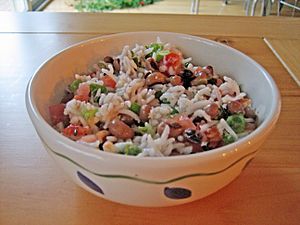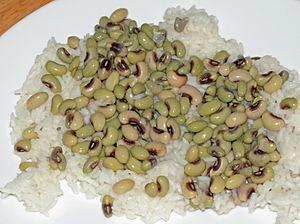Hoppin' John facts for kids
 |
|
| Alternative names | Carolina peas and rice |
|---|---|
| Course | Meal |
| Place of origin | Southern United States |
| Region or state | The Carolinas |
| Main ingredients | Black-eyed peas and rice, chopped onion, sliced bacon |
| Variations | substitute ham hock, fatback, or country sausage for the conventional bacon, or smoked turkey parts as a pork alternative. |
Hoppin' John, also known as Carolina peas and rice, is a tasty dish from the Southern United States. It's made with black-eyed peas (or other types of cowpeas) and rice. Cooks often add chopped onion and sliced bacon. Some recipes use other meats like ham hock or country sausage. You might also find versions with green peppers or vinegar and spices.
In the southern United States, eating Hoppin' John on New Year's Day is a special tradition. People believe it brings good luck and a successful year. The peas are said to look like pennies or coins. Sometimes, a real coin is even put into the pot or under the dinner bowls for extra luck! Other green leafy vegetables, like Collard greens or cabbage, are often served with Hoppin' John. These greens are thought to add to your wealth because they are the color of money. Cornbread is another traditional food served with it. Its golden color can also represent wealth. The day after New Year's Day, any leftover Hoppin' John is sometimes called "Skippin' Jenny." This name suggests being smart with your money, hoping for even more good fortune in the new year.
Why the Name?
The exact origin of the name "Hoppin' John" is a bit of a mystery. One of the first times the dish was mentioned in writing was in a book from 1838. A recipe for "Hopping John" also appeared in a cookbook called The Carolina Housewife in 1847.
One idea is that the name might come from a Haitian Creole term. In Haitian Creole, "pois pigeons" means "pigeon peas," which are similar to black-eyed peas. Over time, this name might have changed into "Hoppin' John."
Where Did it Come From?
Hoppin' John first became popular in the South Carolina Lowcountry. This area is known for its unique food traditions. From there, the dish spread across the entire Southern United States.
Many historians believe Hoppin' John came from West African cooking. Enslaved West Africans brought their food traditions with them to the Americas. They often ate mixtures of rice and beans. Hoppin' John is similar to a Senegalese dish called thiebou niebe.
There are some fun traditions connected to Hoppin' John. One tradition says that each person should leave three peas on their plate. This is supposed to bring luck, good fortune, and even romance in the New Year. Another tradition suggests counting the peas in your serving. The number of peas is said to predict how much luck or wealth you will have! On Sapelo Island, people sometimes use Sea Island red peas instead of black-eyed peas. These peas are very similar.
A famous American chef named Sean Brock has helped bring back old ways of making Hoppin' John. He says that the traditional dish used a special type of rice called Carolina Gold and Sea Island red peas. He has worked with farmers to grow these traditional ingredients again.
Other Similar Dishes
You can find many dishes like Hoppin' John throughout the American South and the Caribbean. These dishes often show the influence of African cooking in the Americas. For example:
- In Guyana, there's a dish called "cook-up rice." It uses black-eyed peas and coconut milk.
- "Hoppin' Juan" is a fun twist that uses Cuban black beans instead of black-eyed peas.
- Peru has a dish called tacu-tacu.
- Brazil has "baião-de-dois," which also often uses black-eyed peas.
See also
 In Spanish: Hoppin' John para niños
In Spanish: Hoppin' John para niños


